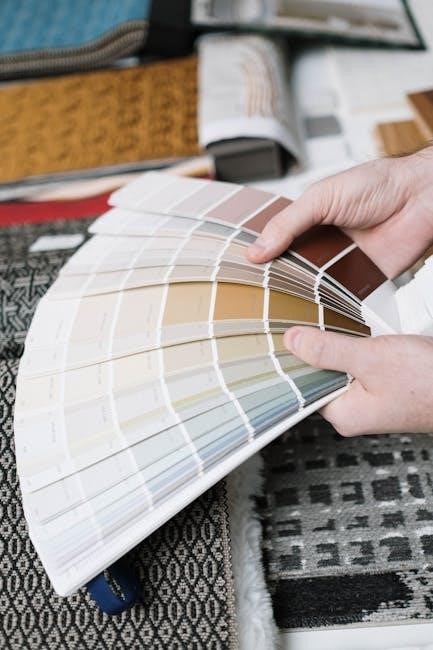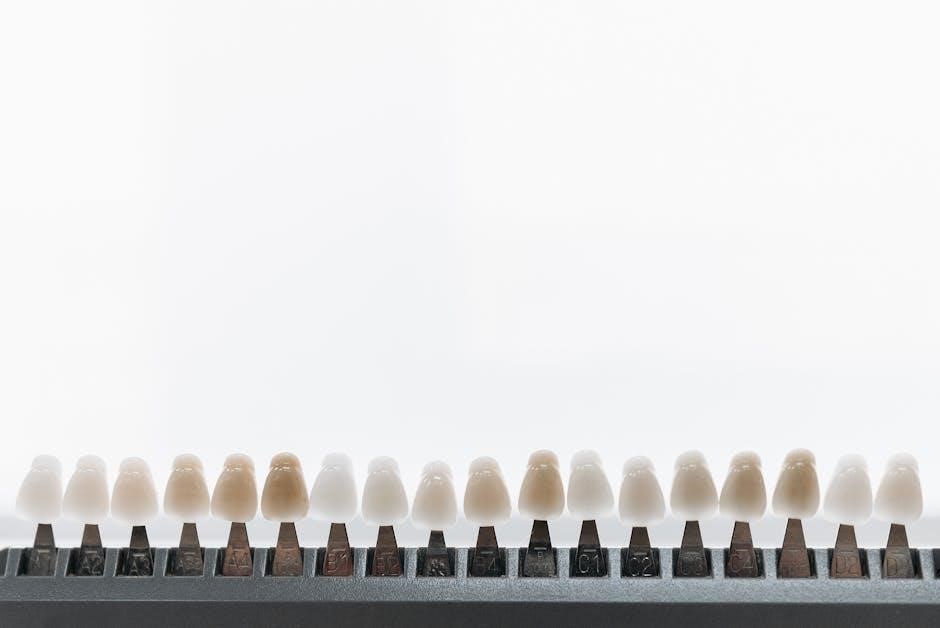Dental shade guides are essential tools in dentistry, enabling accurate tooth color matching for restorations. They ensure natural aesthetics, functional outcomes, and greatly enhance patient satisfaction.
1.1 Definition and Purpose
A dental shade guide is a standardized tool used in dentistry to match the color of teeth for restorative procedures. It consists of a series of tooth-colored samples arranged in a specific order, representing natural tooth shades. The primary purpose of a dental shade guide is to ensure accurate color matching for dental restorations, such as crowns, veneers, and implants. This tool helps dentists achieve aesthetically pleasing and functional outcomes, ensuring that the restoration blends seamlessly with the patient’s natural teeth. By streamlining the color selection process, dental shade guides enhance efficiency and patient satisfaction, making them indispensable in modern dental practice.
1.2 Importance in Dentistry
Dental shade guides play a pivotal role in ensuring precise tooth color matching, which is critical for both aesthetic and functional dental restorations. Accurate shade selection enhances patient satisfaction by creating natural-looking results, fostering trust in dental care. These tools also streamline the restoration process, reducing errors and the need for remakes. By providing a standardized reference, shade guides improve communication between dentists, laboratories, and patients, ensuring consistent outcomes. Their importance extends to maintaining high standards in cosmetic and restorative dentistry, making them an indispensable asset in modern dental practice.

History and Evolution of Dental Shade Guides
The development of dental shade guides began with early attempts to standardize tooth color matching, evolving from basic systems to sophisticated tools integrating modern technology.
2.1 Early Developments in Tooth Color Matching
The origins of tooth color matching trace back to early dental practices, where rudimentary systems were used to replicate natural tooth hues. In the late 19th century, dentists began experimenting with porcelain to create more lifelike restorations, leading to the development of basic shade guides. These early tools were often limited in scope and variability, relying on manual comparisons and subjective judgments. The introduction of standardized shade systems in the early 20th century marked a significant milestone, laying the foundation for modern dental shade guides. This evolution reflects the growing emphasis on aesthetics and precision in dental care.
- Early systems focused on basic color categorization.
- Standardization improved consistency across dental practices.
- These developments paved the way for advanced shade matching technologies.
2.2 Modern Advancements in Shade Guide Technology

Modern dental shade guide technology has revolutionized tooth color matching, offering enhanced accuracy and efficiency. Digital shade guides now utilize advanced spectrophotometers to measure tooth color objectively, reducing human error. Artificial intelligence and machine learning algorithms improve shade selection by analyzing data from thousands of cases. Additionally, 3D printing enables the creation of custom shade guides tailored to individual patient needs. These innovations ensure more precise and predictable outcomes, aligning with the growing demand for esthetic and personalized dentistry. Such advancements underscore the integration of technology in modern dental practices, elevating both patient satisfaction and clinical success.
- Digital tools enhance precision in color matching.
- AI and machine learning optimize shade selection.
- 3D printing allows for custom solutions.

Types of Dental Shade Guides
Dental shade guides are categorized into classic, digital, and custom types. Classic guides use standardized tooth shades, while digital guides employ advanced technology for precise color matching. Custom guides are tailored to individual patient needs, ensuring optimal aesthetic results.
- Classic Shade Guides
- Digital Shade Guides
- Custom Shade Guides
3.1 Classic Shade Guides
Classic shade guides are traditional tools used in dentistry for tooth color matching. They consist of a set of standardized ceramic or plastic tabs arranged in a specific order of shades. These guides are widely used for their simplicity and cost-effectiveness. Dentists typically compare the patient’s tooth color to the guide under controlled lighting conditions to select the most accurate shade. While they are effective for routine procedures, classic shade guides may lack precision in complex cases due to human error and subjective interpretation. Despite advancements, they remain a foundational tool in dental practices worldwide.
- Standardized ceramic or plastic tabs
- Used for routine tooth color matching
- Depend on visual comparison
- Cost-effective and widely available
3.2 Digital Shade Guides
Digital shade guides represent a modern advancement in tooth color matching, offering enhanced accuracy and efficiency. These systems use intraoral cameras and specialized software to capture and analyze tooth shades digitally. They provide real-time data, reducing human error and improving consistency. Digital guides often include libraries of shades and can store patient data for future reference. While they require initial investment in equipment and training, they streamline the shade-matching process and integrate seamlessly with CAD/CAM systems for precise prosthetics. Their ability to enhance communication between dentists, labs, and patients makes them a valuable tool in contemporary dentistry.
- Use intraoral cameras and software
- Provide real-time, accurate shade analysis
- Store patient data for future use
- Integrate with CAD/CAM systems
- Enhance communication between teams
3.3 Custom Shade Guides
Digital shade guides represent a modern advancement in tooth color matching, offering enhanced accuracy and efficiency. These systems use intraoral cameras and specialized software to capture and analyze tooth shades digitally. They provide real-time data, reducing human error and improving consistency. Digital guides often include libraries of shades and can store patient data for future reference. While they require initial investment in equipment and training, they streamline the shade-matching process and integrate seamlessly with CAD/CAM systems for precise prosthetics. Their ability to enhance communication between dentists, labs, and patients makes them a valuable tool in contemporary dentistry.
- Use intraoral cameras and software
- Provide real-time, accurate shade analysis
- Store patient data for future use
- Integrate with CAD/CAM systems
- Enhance communication between teams
The Process of Using a Dental Shade Guide
The process involves preparation, shade matching under controlled lighting, and verification. It ensures accurate, aesthetically pleasing results, enhancing patient satisfaction and communication;
4.1 Preparation for Shade Matching
Preparation is crucial for accurate shade matching. The dentist ensures the tooth is clean and dry, free from temporary cements or debris; Proper lighting conditions are essential, ideally natural daylight or high-quality LED lights. Shade tabs are arranged systematically, and the patient’s surrounding teeth are evaluated for color reference. Communication between the dentist and patient is key to align expectations. The process also involves documenting the initial shade for future reference. These steps ensure a standardized approach, minimizing errors and enhancing the precision of the shade matching procedure.
4.2 Step-by-Step Shade Matching Procedure
The shade matching process begins with selecting a suitable shade guide. The dentist compares the tooth under neutral lighting, often using a shade tab closest to the tooth’s color. The patient is involved to ensure satisfaction. The shade is documented, and a mock-up may be created for verification. The procedure is repeated until both dentist and patient agree on the match. This systematic approach ensures accuracy and consistency, leveraging both clinical expertise and patient input for optimal aesthetic and functional results.
4.3 Verification and Adjustment
Verification and adjustment are critical steps in achieving accurate shade matching. After selecting a shade, the dentist verifies it under different lighting conditions to ensure consistency. Trial pastes or mock-ups may be used to simulate the final result. The patient’s input is invaluable during this phase, as their perception of color plays a significant role. Adjustments are made iteratively, fine-tuning the shade for optimal aesthetics. This process ensures the chosen shade aligns with both clinical standards and patient expectations, ultimately enhancing the success of the dental restoration.

Challenges and Limitations
Dental shade guides face challenges like human error, lighting variability, and subjective color perception. Limited shade options and tooth color variations can complicate achieving precise matches.

5.1 Common Challenges in Shade Matching
Shade matching in dentistry presents several challenges, including human error and variability in lighting conditions. The subjective nature of color perception among clinicians and patients can lead to discrepancies. Additionally, natural tooth color variations, such as translucency and undertones, complicate accurate matching. Limited shade options in traditional guides further exacerbate these issues. These factors highlight the need for precise communication and advanced tools to achieve optimal aesthetic and functional outcomes, ensuring patient satisfaction and clinical success in dental restorations.
5.2 Limitations of Traditional Shade Guides
Traditional dental shade guides have inherent limitations that affect accuracy and consistency. The finite number of shades available often fails to cover the full spectrum of natural tooth colors, leading to compromises in matching. Additionally, the subjective nature of visual comparison introduces variability among clinicians. Lighting conditions and the human eye’s perception further complicate precise shade selection. These factors can result in mismatches, impacting the aesthetic outcomes of restorations. Moreover, traditional guides lack the ability to account for tooth translucency and undertones, which are critical for achieving natural-looking results. These limitations underscore the need for advanced, technology-driven solutions in modern dentistry.
Advancements in Dental Shade Guide Technology
Modern advancements in dental shade guides include AI-powered systems and 3D printing. These technologies enhance accuracy, efficiency, and customization, offering precise color matching and streamlined workflows for dentists.
6.1 Role of Artificial Intelligence (AI)
Artificial Intelligence (AI) revolutionizes dental shade matching by automating and enhancing accuracy; AI systems analyze data from digital scans and patient records to recommend optimal shades. Machine learning algorithms improve with each use, reducing human error. AI also enables real-time color matching, adapting to lighting conditions. This technology streamlines the process, saving time and improving patient outcomes. Additionally, AI can predict shade preferences based on facial features and skin tone, offering personalized solutions. By integrating AI, dentists achieve more precise and efficient shade matching, ensuring natural-looking restorations and higher patient satisfaction.

6.2 3D Printing and Digital Dentistry
3D printing and digital dentistry have transformed dental shade guide applications. Digital tools create precise, customizable shade guides, enabling accurate color matching for restorations. 3D printing allows fabrication of physical guides tailored to individual patients, improving aesthetics and fit. Digital dentistry integrates shade matching with CAD/CAM systems, streamlining workflows. These technologies enhance communication between dentists and labs, ensuring consistent results. They also reduce material waste and production time. By combining digital data with 3D printing, dentists achieve highly personalized and efficient shade matching solutions, advancing the field of restorative dentistry and patient care.

Maintenance and Care of Dental Shade Guides
Proper handling and storage of dental shade guides are crucial for longevity. Regular calibration ensures accuracy, while protective cases prevent damage, maintaining their effectiveness in clinical settings.
7.1 Proper Handling and Storage
Proper handling and storage of dental shade guides are vital for maintaining their accuracy and longevity. They should be stored in protective cases to prevent damage and contamination. Regular cleaning with soft cloths and mild disinfectants ensures hygiene. Avoid exposure to extreme temperatures or direct sunlight, as this can alter shade accuracy. Handle guides gently to prevent chipping or fading of tabs. Calibration checks should be performed periodically to ensure reliability. By following these practices, dental professionals can extend the lifespan of their shade guides and maintain consistent, precise color matching in clinical settings.
7.2 Calibration and Updates
Calibration and updates are crucial for maintaining the accuracy and functionality of dental shade guides. Regular calibration ensures that the guide remains consistent with standardized shade values, preventing color drift over time. For digital guides, software updates often enhance features, improve color matching algorithms, and address technical issues. Manufacturers provide specific calibration protocols, which should be followed meticulously. Additionally, updating shade libraries or replacing worn tabs can improve precision. Staying current with the latest advancements ensures that dental professionals can deliver consistent and reliable results in shade matching, ultimately benefiting patient outcomes and practice efficiency.

Case Studies and Clinical Examples
Case studies highlight real-life applications of dental shade guides, showcasing successful outcomes and lessons learned. These examples demonstrate how accurate shade matching enhances restoration aesthetics and patient satisfaction significantly.
8.1 Successful Shade Matching Outcomes
Successful shade matching outcomes are crucial for achieving natural-looking dental restorations. These outcomes ensure that prosthetics, veneers, and crowns blend seamlessly with natural teeth, enhancing both aesthetics and functionality.
Clinical examples often highlight cases where precise shade matching led to high patient satisfaction. For instance, a patient with discolored teeth achieved a uniform smile after using advanced digital shade guides.
Such successes demonstrate the importance of accurate color matching in restoring confidence and oral health. These outcomes also underscore the value of modern dental technologies in achieving predictable, aesthetically pleasing results.
8.2 Lessons Learned from Clinical Practice
Clinical practice has revealed key lessons in dental shade matching, emphasizing the importance of precise communication between dentists and technicians.
- Lighting conditions significantly impact color perception, requiring consistent environments for accurate matching;
- Patient expectations must be managed to ensure satisfaction with the final aesthetic outcome.
- Digital tools have proven invaluable in reducing errors and enhancing predictability.
These insights highlight the need for continuous training and adaptation to advancing technologies, ensuring optimal results in restorative dentistry.
Patient Education and Communication
Effective communication is crucial for patient understanding of dental shade matching.
- Explaining the process clearly ensures realistic expectations.
- Patients value involvement in decisions about their care.
Clear dialogue enhances trust and satisfaction in aesthetic outcomes.
9.1 Explaining the Shade Matching Process
Clear communication about the shade matching process is vital for patient understanding. Dentists use shade guides to select the most natural tooth color for restorations. The process involves matching the hue, chroma, and value of the patient’s teeth. Patients are often shown the guide to involve them in decisions. This transparency builds trust and ensures satisfaction. The dentist may also explain how lighting and angles affect color perception. By educating patients, they can better understand the precision and care behind achieving aesthetic results, making the process collaborative and confidence-building.
9.2 Managing Patient Expectations
Managing patient expectations is crucial for satisfaction in dental shade matching. Patients often have high hopes for aesthetic results, so clear communication is key. Dentists should explain the process and set realistic goals, ensuring patients understand that shade matching is both art and science. Using visual aids like shade guides can help patients visualize outcomes. It’s important to align expectations with what is achievable, considering factors like tooth structure and lighting conditions. By fostering open dialogue and addressing concerns, dentists can build trust and ensure patients are pleased with the final result, even if minor adjustments are needed. This approach enhances overall satisfaction and confidence in the treatment.
Future Trends in Dental Shade Guides
Future trends in dental shade guides include advanced AI integration, real-time color matching, and personalized solutions. These innovations aim to enhance accuracy and streamline the shade matching process.
10.1 Emerging Technologies
Emerging technologies in dental shade guides are revolutionizing the field, with AI-driven systems enabling real-time color matching and predictive analytics. These tools enhance accuracy and efficiency, reducing human error. Digital platforms now integrate seamlessly with CAD/CAM systems, streamlining workflows. Portable shade-matching devices are gaining popularity, offering convenience and precision. Additionally, advancements in 3D printing allow for custom shade guides tailored to individual patient needs. These innovations are reshaping how dentists approach tooth color matching, ensuring more natural and aesthetically pleasing outcomes. The future promises even greater integration of technology, further elevating the standards of dental care and patient satisfaction.

10.2 Personalized Dentistry and Shade Matching
Personalized dentistry is transforming shade matching by tailoring solutions to individual patient needs. Advanced technologies like 3D printing enable custom shade guides, offering precise color replication. AI-driven systems analyze patient data to predict optimal shades, enhancing accuracy. This approach ensures natural aesthetics and functional harmony. Patients benefit from unique, patient-specific solutions, improving satisfaction. The integration of digital tools and custom options is setting new standards in dentistry, making shade matching more efficient and personalized than ever before. This shift toward individualization is expected to continue, driving innovation in dental care and patient outcomes.
Dental shade guides have evolved significantly, enhancing precision and aesthetics in dentistry. Their integration with AI and digital tools promises a future of personalized, efficient, and patient-centric care.
11.1 Summary of Key Points
Dental shade guides are indispensable tools in modern dentistry, ensuring precise tooth color matching for restorations. They enhance aesthetics, functionality, and patient satisfaction. From classic to digital and custom guides, their evolution reflects advancing technology. Challenges like human error and limited accuracy persist, but innovations such as AI and 3D printing promise improved outcomes. Proper maintenance and patient communication are crucial for successful shade matching. The integration of digital tools and personalized approaches highlights the future of dentistry, balancing technological advancements with clinical expertise to meet growing patient expectations for natural, tailored results.
11.2 Final Thoughts on the Evolution of Dental Shade Guides
The evolution of dental shade guides reflects a journey from manual, subjective tools to advanced, technology-driven solutions. Classic guides laid the foundation, while digital and custom options now offer unprecedented precision. AI and 3D printing are revolutionizing shade matching, enabling faster and more accurate results. Despite challenges like human error and limited standardization, the future holds promise with personalized dentistry and real-time matching. As technology advances, dental shade guides will continue to bridge the gap between aesthetics and functionality, ensuring natural, patient-specific outcomes. The integration of innovation and clinical expertise will shape the next chapter in this essential dental tool’s development.
